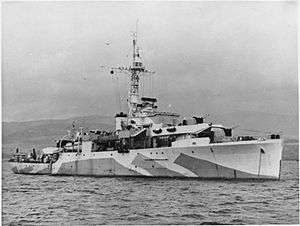HMS Amethyst (F116)
 Amethyst during the Second World War | |
| History | |
|---|---|
| Name: | HMS Amethyst |
| Builder: | Alexander Stephen and Sons, Govan |
| Laid down: | 25 March 1942 |
| Launched: | 7 May 1943 |
| Commissioned: | 2 November 1943 |
| Identification: | Pennant number: U16 (later F116) |
| Fate: | Scrapped 19 January 1957 |
| General characteristics | |
| Class and type: | Modified Black Swan-class sloop |
| Displacement: | 1,350 tons |
| Length: | 283 ft (86 m) |
| Beam: | 38.5 ft (11.7 m) |
| Propulsion: |
|
| Speed: | 20 knots (37 km/h) at 4,300 hp (3,200 kW) |
| Complement: | 192 men |
| Armament: |
|
HMS Amethyst was a modified Black Swan-class sloop of the Royal Navy. She was laid down by Alexander Stephen and Sons of Linthouse, Govan Scotland on 25 March 1942, launched on 7 May 1943 and commissioned on 2 November 1943, with the pennant number U16. After the Second World War she was modified and redesignated as a frigate, and renumbered F116.
Second World War
During World War II, Amethyst was deployed mostly on anti-submarine patrols and escort duties. On 20 February 1945 she attacked and sank the U-boat U-1276 with depth charges. U-1276 had just sunk HMS Vervain, a Flower-class corvette. The action took place in the North Atlantic, south of Waterford and resulted in the loss of all 49 of the U-boat's crew.
During the war the Amethyst was credited, along with the sloops Starling, Peacock, Hart, and frigate Loch Craggie, with sinking the German submarine U-482 in the North Channel on 16 January 1945. The British Admiralty withdrew this credit in a post-war reassessment.[1]
The Yangtze Incident
On 20 April 1949, Amethyst was on her way from Shanghai to Nanking (now Nanjing) when she was fired upon by the People's Liberation Army, thus starting the Amethyst Incident. Amethyst was trapped in China until 30 July 1949 when she escaped under cover of darkness.
For the 1957 film Yangtse Incident: The Story of HMS Amethyst, Amethyst was brought out of storage to play herself. As her engines were no longer operational, her sister ship, Magpie, was used for shots of the ship moving. Amethyst was scrapped shortly after the filming was finished.[2]
See also
References
- ↑ Blair (2000), 630-631.
- ↑ "The Yangtse Incident:the story of HMS Amethyst". British Lion Films. British Lion Holdings Ltd. Retrieved 27 April 2016.
References
- Colledge, J. J.; Warlow, Ben (2006) [1969]. Ships of the Royal Navy: The Complete Record of all Fighting Ships of the Royal Navy (Rev. ed.). London: Chatham Publishing. ISBN 978-1-86176-281-8. OCLC 67375475.
- Hague, Arnold (1993). Sloops: A History of the 71 Sloops Built in Britain and Australia for the British, Australian and Indian Navies 1926–1946. Kendal, England: World Ship Society. ISBN 0-905617-67-3.
Further reading
- Blair, Clay (2000). Hitler's U-Boat War: The Hunted 1942–1945. New York: Modern Library. ISBN 0-679-64033-9.
- Leslie Frank - Yangtse River Incident 1949: The Diary of Coxswain Leslie Frank: HMS Amethyst - Yangtse River 19/4/49 to 31/7/49 (2004) ISBN 1-84342-756-7
- Edwyn Gray - Frigate Under Fire: HMS Amethyst's 100 Days of Hell (1987)
- Malcolm H. Murfett - Hostage on the Yangtze: Britain, China, and the Amethyst Crisis of 1949 (1991) ISBN 0-87021-289-3